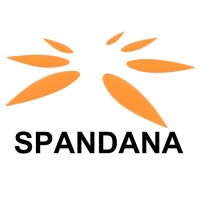
Spandana Sphoorty Financial Limited Company Cyber Security Posture
spandanasphoorty.comSpandana Sphoorty Financial Limited (SSFL) has been operating as a Non-Banking Finance Company (NBFC) incorporated under the Companies Act, 1956 and licensed by the Reserve Bank of India under the Reserve Bank of India Act, 1934 to carry on the business of a Non-Banking Financial Institution without accepting public deposits. With the release of NBFC- Micro Finance Institution (NBFC-MFI) as a new category of NBFCs, the company has been reclassified as NBFC-MFI effective April 13, 2015. The micro-credit program of Spandana started in 1998 when Spandana operated as a Society (Spandana Urban and Rural Development Organisation – SURDO). Later, it formalized itself into an NBFC (SSFL). Spandana’s lending program is committed to strengthening the socio-economic status of low-income households – particularly women – in rural and urban areas by providing financial services continually to improve livelihoods, establish identity and enhance self-esteem. Spandana follows both the group-based and the individual micro-credit lending model wherein in both models, the loans are given to individuals based on their household economics. Besides micro-credit, it has other products – like – Farm Equipment, loans against Gold jewellery, etc. For more information, please visit us at www.spandanasphoorty.com We are on Social Media Facebook - https://www.facebook.com/profile.php?id=100088770888545 Instagram - https://www.instagram.com/spandanasphoorty__/ Twitter - https://x.com/SSphoorty Youtube - https://youtu.be/3SnAyVMBORQ
SSFL Company Details
spandana-sphoorty-financial-limited
10,001+ employees
44592
52
Financial Services
spandanasphoorty.com
2
SPA_1984226
In-progress
Between 800 and 900
This score is AI-generated and less favored by cyber insurers, who prefer the TPRM score.
 SSFL Global Score
SSFL Global Score.png)

Spandana Sphoorty Financial Limited Company Scoring based on AI Models
| Model Name | Date | Description | Current Score Difference | Score |
|---|---|---|---|---|
| AVERAGE-Industry | 03-12-2025 | This score represents the average cybersecurity rating of companies already scanned within the same industry. It provides a benchmark to compare an individual company's security posture against its industry peers. | N/A | Between 800 and 900 |
Spandana Sphoorty Financial Limited Company Cyber Security News & History
| Entity | Type | Severity | Impact | Seen | Url ID | Details | View |
|---|
Spandana Sphoorty Financial Limited Company Subsidiaries

Spandana Sphoorty Financial Limited (SSFL) has been operating as a Non-Banking Finance Company (NBFC) incorporated under the Companies Act, 1956 and licensed by the Reserve Bank of India under the Reserve Bank of India Act, 1934 to carry on the business of a Non-Banking Financial Institution without accepting public deposits. With the release of NBFC- Micro Finance Institution (NBFC-MFI) as a new category of NBFCs, the company has been reclassified as NBFC-MFI effective April 13, 2015. The micro-credit program of Spandana started in 1998 when Spandana operated as a Society (Spandana Urban and Rural Development Organisation – SURDO). Later, it formalized itself into an NBFC (SSFL). Spandana’s lending program is committed to strengthening the socio-economic status of low-income households – particularly women – in rural and urban areas by providing financial services continually to improve livelihoods, establish identity and enhance self-esteem. Spandana follows both the group-based and the individual micro-credit lending model wherein in both models, the loans are given to individuals based on their household economics. Besides micro-credit, it has other products – like – Farm Equipment, loans against Gold jewellery, etc. For more information, please visit us at www.spandanasphoorty.com We are on Social Media Facebook - https://www.facebook.com/profile.php?id=100088770888545 Instagram - https://www.instagram.com/spandanasphoorty__/ Twitter - https://x.com/SSphoorty Youtube - https://youtu.be/3SnAyVMBORQ
Access Data Using Our API

Get company history
.png)
SSFL Cyber Security News
NBFC CISOs – Battle Ready
Top NBFC CISOs share insights on cyberthreats, solutions, rising costs, and the evolution of internal cybersecurity teams.
Scandal Rocks Spandana: ₹1,035 Crore Loss Triggers "Fraud & Collusion" Alert from Auditors!
Spandana Sphoorty Financial is in the eye of a financial storm after reporting a ₹434 crore net loss in Q4 FY25 and a staggering ₹1035 crore ...
Spandana Sphoorty MD Shalabh Saxena resigns, Ashish Damani takes charge as interim CEO
Spandana Sphoorty Financial's MD, Shalabh Saxena, has resigned to explore new career paths, prompting the appointment of Ashish Kumar Damani ...
Average cost of data breaches in India hits $2.18 million: RBI report
The average cost of data breaches in India reached $2.18 million in 2023, marking a 28 per cent increase since 2020, according to the ...
Digital & Financial Literacy Program introduced to empower communities
This initiative offers a 5 hour training course designed to allow the participants aged between 18 to 60 with personal finance management skills and digital ...
Dharmvir S Appointed as Chief Technology Officer of Sammaan Capital
Sammaan Capital Limited has appointed Dharmvir S as its new Chief Technology Officer (CTO), entrusting him with leading the company's IT ...
India's average data breach costs hit $2.18 mn in 2023, up 28% since 2020
India's average data breach costs hit $2.18 mn in 2023, up 28% since 2020 · Phishing is the most prevalent form of cyberattack in India, ...

SSFL Similar Companies

Ullink - now part of Broadridge Trading and Connectivity Solutions
Ullink is now part of Broadridge. Broadridge Financial Solutions (NYSE: BR), a global Fintech leader with $5 billion in revenues, provides the critical infrastructure that powers investing, corporate governance, and communications to enable better financial lives. We deliver technology-driven sol

Lincoln Financial
Lincoln Financial (NYSE: LNC) helps people to confidently plan for their version of a successful future. We focus on identifying a clear path to financial security, with products including annuities, life insurance, group protection, and retirement plan services. With our 120-year track record of

Principal Financial Group
Principal Financial Group® is dedicated to improving the wealth and well-being of people and businesses around the world—helping more than 62M customers plan, protect, invest, and retire as of December 31, 2023. Along the way, we commit to supporting the communities where we do business. Improving o

Sun Life
Sun Life is a leading financial services organization dedicated to helping people achieve lifetime financial security and live healthier lives. We provide a wide range of insurance and investment products and services in key markets around the world including Canada, the United States, the United K

Rockall Technologies (now Broadridge)
Rockall Technologies is now a part of Broadridge. Broadridge Financial Solutions (NYSE: BR), a global Fintech leader with $5 billion in revenues, provides the critical infrastructure that powers investing, corporate governance, and communications to enable better financial lives. We deliver tech

XP Inc.
A XP Inc. é uma das maiores instituições financeiras independente do Brasil, dona das marcas XP, Rico, Clear, XP Educação, InfoMoney, entre outras. Com mais de 4,6 milhões de clientes ativos e um valor superior a R$ 1,1 trilhão de ativos sob custódia, há 23 anos vem transformando o mercado financeir

Frequently Asked Questions (FAQ) on Cybersecurity Incidents
SSFL CyberSecurity History Information
Total Incidents: According to Rankiteo, SSFL has faced 0 incidents in the past.
Incident Types: As of the current reporting period, SSFL has not encountered any cybersecurity incidents.
Total Financial Loss: The total financial loss from these incidents is estimated to be {total_financial_loss}.
Cybersecurity Posture: The company's overall cybersecurity posture is described as Spandana Sphoorty Financial Limited (SSFL) has been operating as a Non-Banking Finance Company (NBFC) incorporated under the Companies Act, 1956 and licensed by the Reserve Bank of India under the Reserve Bank of India Act, 1934 to carry on the business of a Non-Banking Financial Institution without accepting public deposits. With the release of NBFC- Micro Finance Institution (NBFC-MFI) as a new category of NBFCs, the company has been reclassified as NBFC-MFI effective April 13, 2015. The micro-credit program of Spandana started in 1998 when Spandana operated as a Society (Spandana Urban and Rural Development Organisation – SURDO). Later, it formalized itself into an NBFC (SSFL). Spandana’s lending program is committed to strengthening the socio-economic status of low-income households – particularly women – in rural and urban areas by providing financial services continually to improve livelihoods, establish identity and enhance self-esteem. Spandana follows both the group-based and the individual micro-credit lending model wherein in both models, the loans are given to individuals based on their household economics. Besides micro-credit, it has other products – like – Farm Equipment, loans against Gold jewellery, etc. For more information, please visit us at www.spandanasphoorty.com We are on Social Media Facebook - https://www.facebook.com/profile.php?id=100088770888545 Instagram - https://www.instagram.com/spandanasphoorty__/ Twitter - https://x.com/SSphoorty Youtube - https://youtu.be/3SnAyVMBORQ.
Detection and Response: The company detects and responds to cybersecurity incidents through {description_of_detection_and_response_process}.
Incident Details
Incident 1: Ransomware Attack
Title: {Incident_Title}
Description: {Brief_description_of_the_incident}
Date Detected: {Detection_Date}
Date Publicly Disclosed: {Disclosure_Date}
Date Resolved: {Resolution_Date}
Type: {Type_of_Attack}
Attack Vector: {Attack_Vector}
Vulnerability Exploited: {Vulnerability}
Threat Actor: {Threat_Actor}
Motivation: {Motivation}
Incident 2: Data Breach
Title: {Incident_Title}
Description: {Brief_description_of_the_incident}
Date Detected: {Detection_Date}
Date Publicly Disclosed: {Disclosure_Date}
Date Resolved: {Resolution_Date}
Type: {Type_of_Attack}
Attack Vector: {Attack_Vector}
Vulnerability Exploited: {Vulnerability}
Threat Actor: {Threat_Actor}
Motivation: {Motivation}
Common Attack Types: As of now, the company has not encountered any reported incidents involving common cyberattacks.
Identification of Attack Vectors: The company identifies the attack vectors used in incidents through {description_of_identification_process}.
Impact of the Incidents
Incident 1: Ransomware Attack
Financial Loss: {Financial_Loss}
Data Compromised: {Data_Compromised}
Systems Affected: {Systems_Affected}
Downtime: {Downtime}
Operational Impact: {Operational_Impact}
Conversion Rate Impact: {Conversion_Rate_Impact}
Revenue Loss: {Revenue_Loss}
Customer Complaints: {Customer_Complaints}
Brand Reputation Impact: {Brand_Reputation_Impact}
Legal Liabilities: {Legal_Liabilities}
Identity Theft Risk: {Identity_Theft_Risk}
Payment Information Risk: {Payment_Information_Risk}
Incident 2: Data Breach
Financial Loss: {Financial_Loss}
Data Compromised: {Data_Compromised}
Systems Affected: {Systems_Affected}
Downtime: {Downtime}
Operational Impact: {Operational_Impact}
Conversion Rate Impact: {Conversion_Rate_Impact}
Revenue Loss: {Revenue_Loss}
Customer Complaints: {Customer_Complaints}
Brand Reputation Impact: {Brand_Reputation_Impact}
Legal Liabilities: {Legal_Liabilities}
Identity Theft Risk: {Identity_Theft_Risk}
Payment Information Risk: {Payment_Information_Risk}
Average Financial Loss: The average financial loss per incident is {average_financial_loss}.
Commonly Compromised Data Types: The types of data most commonly compromised in incidents are {list_of_commonly_compromised_data_types}.
Incident 1: Ransomware Attack
Entity Name: {Entity_Name}
Entity Type: {Entity_Type}
Industry: {Industry}
Location: {Location}
Size: {Size}
Customers Affected: {Customers_Affected}
Incident 2: Data Breach
Entity Name: {Entity_Name}
Entity Type: {Entity_Type}
Industry: {Industry}
Location: {Location}
Size: {Size}
Customers Affected: {Customers_Affected}
Response to the Incidents
Incident 1: Ransomware Attack
Incident Response Plan Activated: {Yes/No}
Third Party Assistance: {Yes/No}
Law Enforcement Notified: {Yes/No}
Containment Measures: {Containment_Measures}
Remediation Measures: {Remediation_Measures}
Recovery Measures: {Recovery_Measures}
Communication Strategy: {Communication_Strategy}
Adaptive Behavioral WAF: {Adaptive_Behavioral_WAF}
On-Demand Scrubbing Services: {On_Demand_Scrubbing_Services}
Network Segmentation: {Network_Segmentation}
Enhanced Monitoring: {Enhanced_Monitoring}
Incident 2: Data Breach
Incident Response Plan Activated: {Yes/No}
Third Party Assistance: {Yes/No}
Law Enforcement Notified: {Yes/No}
Containment Measures: {Containment_Measures}
Remediation Measures: {Remediation_Measures}
Recovery Measures: {Recovery_Measures}
Communication Strategy: {Communication_Strategy}
Adaptive Behavioral WAF: {Adaptive_Behavioral_WAF}
On-Demand Scrubbing Services: {On_Demand_Scrubbing_Services}
Network Segmentation: {Network_Segmentation}
Enhanced Monitoring: {Enhanced_Monitoring}
Incident Response Plan: The company's incident response plan is described as {description_of_incident_response_plan}.
Third-Party Assistance: The company involves third-party assistance in incident response through {description_of_third_party_involvement}.
Data Breach Information
Incident 2: Data Breach
Type of Data Compromised: {Type_of_Data}
Number of Records Exposed: {Number_of_Records}
Sensitivity of Data: {Sensitivity_of_Data}
Data Exfiltration: {Yes/No}
Data Encryption: {Yes/No}
File Types Exposed: {File_Types}
Personally Identifiable Information: {Yes/No}
Prevention of Data Exfiltration: The company takes the following measures to prevent data exfiltration: {description_of_prevention_measures}.
Handling of PII Incidents: The company handles incidents involving personally identifiable information (PII) through {description_of_handling_process}.
Ransomware Information
Incident 1: Ransomware Attack
Ransom Demanded: {Ransom_Amount}
Ransom Paid: {Ransom_Paid}
Ransomware Strain: {Ransomware_Strain}
Data Encryption: {Yes/No}
Data Exfiltration: {Yes/No}
Ransom Payment Policy: The company's policy on paying ransoms in ransomware incidents is described as {description_of_ransom_payment_policy}.
Data Recovery from Ransomware: The company recovers data encrypted by ransomware through {description_of_data_recovery_process}.
Regulatory Compliance
Incident 1: Ransomware Attack
Regulations Violated: {Regulations_Violated}
Fines Imposed: {Fines_Imposed}
Legal Actions: {Legal_Actions}
Regulatory Notifications: {Regulatory_Notifications}
Incident 2: Data Breach
Regulations Violated: {Regulations_Violated}
Fines Imposed: {Fines_Imposed}
Legal Actions: {Legal_Actions}
Regulatory Notifications: {Regulatory_Notifications}
Regulatory Frameworks: The company complies with the following regulatory frameworks regarding cybersecurity: {list_of_regulatory_frameworks}.
Ensuring Regulatory Compliance: The company ensures compliance with regulatory requirements through {description_of_compliance_measures}.
Lessons Learned and Recommendations
Incident 1: Ransomware Attack
Lessons Learned: {Lessons_Learned}
Incident 2: Data Breach
Lessons Learned: {Lessons_Learned}
Incident 1: Ransomware Attack
Recommendations: {Recommendations}
Incident 2: Data Breach
Recommendations: {Recommendations}
Key Lessons Learned: The key lessons learned from past incidents are {list_of_key_lessons_learned}.
Implemented Recommendations: The company has implemented the following recommendations to improve cybersecurity: {list_of_implemented_recommendations}.
References
Additional Resources: Stakeholders can find additional resources on cybersecurity best practices at {list_of_additional_resources}.
Investigation Status
Incident 1: Ransomware Attack
Investigation Status: {Investigation_Status}
Incident 2: Data Breach
Investigation Status: {Investigation_Status}
Communication of Investigation Status: The company communicates the status of incident investigations to stakeholders through {description_of_communication_process}.
Stakeholder and Customer Advisories
Incident 1: Ransomware Attack
Stakeholder Advisories: {Stakeholder_Advisories}
Customer Advisories: {Customer_Advisories}
Incident 2: Data Breach
Stakeholder Advisories: {Stakeholder_Advisories}
Customer Advisories: {Customer_Advisories}
Advisories Provided: The company provides the following advisories to stakeholders and customers following an incident: {description_of_advisories_provided}.
Initial Access Broker
Incident 1: Ransomware Attack
Entry Point: {Entry_Point}
Reconnaissance Period: {Reconnaissance_Period}
Backdoors Established: {Backdoors_Established}
High Value Targets: {High_Value_Targets}
Data Sold on Dark Web: {Yes/No}
Incident 2: Data Breach
Entry Point: {Entry_Point}
Reconnaissance Period: {Reconnaissance_Period}
Backdoors Established: {Backdoors_Established}
High Value Targets: {High_Value_Targets}
Data Sold on Dark Web: {Yes/No}
Monitoring and Mitigation of Initial Access Brokers: The company monitors and mitigates the activities of initial access brokers through {description_of_monitoring_and_mitigation_measures}.
Post-Incident Analysis
Incident 1: Ransomware Attack
Root Causes: {Root_Causes}
Corrective Actions: {Corrective_Actions}
Incident 2: Data Breach
Root Causes: {Root_Causes}
Corrective Actions: {Corrective_Actions}
Post-Incident Analysis Process: The company's process for conducting post-incident analysis is described as {description_of_post_incident_analysis_process}.
Corrective Actions Taken: The company has taken the following corrective actions based on post-incident analysis: {list_of_corrective_actions_taken}.
Additional Questions
General Information
Ransom Payment History: The company has {paid/not_paid} ransoms in the past.
Last Ransom Demanded: The amount of the last ransom demanded was {last_ransom_amount}.
Last Attacking Group: The attacking group in the last incident was {last_attacking_group}.
Incident Details
Most Recent Incident Detected: The most recent incident detected was on {most_recent_incident_detected_date}.
Most Recent Incident Publicly Disclosed: The most recent incident publicly disclosed was on {most_recent_incident_publicly_disclosed_date}.
Most Recent Incident Resolved: The most recent incident resolved was on {most_recent_incident_resolved_date}.
Impact of the Incidents
Highest Financial Loss: The highest financial loss from an incident was {highest_financial_loss}.
Most Significant Data Compromised: The most significant data compromised in an incident was {most_significant_data_compromised}.
Most Significant System Affected: The most significant system affected in an incident was {most_significant_system_affected}.
Response to the Incidents
Third-Party Assistance in Most Recent Incident: The third-party assistance involved in the most recent incident was {third_party_assistance_in_most_recent_incident}.
Containment Measures in Most Recent Incident: The containment measures taken in the most recent incident were {containment_measures_in_most_recent_incident}.
Data Breach Information
Most Sensitive Data Compromised: The most sensitive data compromised in a breach was {most_sensitive_data_compromised}.
Number of Records Exposed: The number of records exposed in the most significant breach was {number_of_records_exposed}.
Ransomware Information
Highest Ransom Demanded: The highest ransom demanded in a ransomware incident was {highest_ransom_demanded}.
Highest Ransom Paid: The highest ransom paid in a ransomware incident was {highest_ransom_paid}.
Regulatory Compliance
Highest Fine Imposed: The highest fine imposed for a regulatory violation was {highest_fine_imposed}.
Most Significant Legal Action: The most significant legal action taken for a regulatory violation was {most_significant_legal_action}.
Lessons Learned and Recommendations
Most Significant Lesson Learned: The most significant lesson learned from past incidents was {most_significant_lesson_learned}.
Most Significant Recommendation Implemented: The most significant recommendation implemented to improve cybersecurity was {most_significant_recommendation_implemented}.
References
Most Recent Source: The most recent source of information about an incident is {most_recent_source}.
Most Recent URL for Additional Resources: The most recent URL for additional resources on cybersecurity best practices is {most_recent_url}.
Investigation Status
Current Status of Most Recent Investigation: The current status of the most recent investigation is {current_status_of_most_recent_investigation}.
Stakeholder and Customer Advisories
Most Recent Stakeholder Advisory: The most recent stakeholder advisory issued was {most_recent_stakeholder_advisory}.
Most Recent Customer Advisory: The most recent customer advisory issued was {most_recent_customer_advisory}.
Initial Access Broker
Most Recent Entry Point: The most recent entry point used by an initial access broker was {most_recent_entry_point}.
Most Recent Reconnaissance Period: The most recent reconnaissance period for an incident was {most_recent_reconnaissance_period}.
Post-Incident Analysis
Most Significant Root Cause: The most significant root cause identified in post-incident analysis was {most_significant_root_cause}.
Most Significant Corrective Action: The most significant corrective action taken based on post-incident analysis was {most_significant_corrective_action}.
What Do We Measure?
















Every week, Rankiteo analyzes billions of signals to give organizations a sharper, faster view of emerging risks. With deeper, more actionable intelligence at their fingertips, security teams can outpace threat actors, respond instantly to Zero-Day attacks, and dramatically shrink their risk exposure window.
These are some of the factors we use to calculate the overall score:
Identify exposed access points, detect misconfigured SSL certificates, and uncover vulnerabilities across the network infrastructure.
Gain visibility into the software components used within an organization to detect vulnerabilities, manage risk, and ensure supply chain security.
Monitor and manage all IT assets and their configurations to ensure accurate, real-time visibility across the company's technology environment.
Leverage real-time insights on active threats, malware campaigns, and emerging vulnerabilities to proactively defend against evolving cyberattacks.




